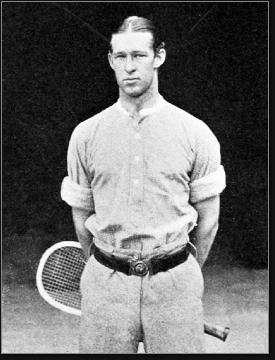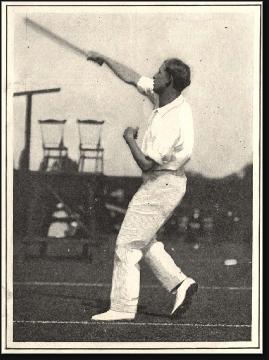
Bill Larned
Sport: Tennis
Born: December 30, 1872
Died: December 15, 1926
Town: Summit
William Augustus Larned was born December 30, 1872 in Summit. The son of a wealthy lawyer, he was a young boy when tennis first crossed the Atlantic and made its way from Staten Island to central New Jersey. Bill learned the game on the family estate, and also distinguished himself as a fine golfer and horseman. He was a deadeye with a rifle.
Bill continued to play tennis in college at Cornell University while studying engineering. In 1892, he won the collegiate tennis championship at the New Haven Lawn Club. Earlier that summer, Bill had entered the U.S. singles championships at Newport and reached the finals, where he lost to Fred Hovey.
During the early years of the tournament, the “all-comers” portion of the event was run as it is today, with a large main draw. However, the winner of the all-comers finals only won a berth in the “challenge round,” where he faced the previous year’s winner for the championship. The defending champ did not have to enter the main draw, so he was fresh for the challenge round against an opponent who had already played five matches.
After graduation, Bill went to work in New York City. He captained the hockey team at the St. Nicholas Rink—the second artificial ice rink in the country—located on the site of present-day Lincoln Center. Meanwhile, Bill continued to compete in the U.S. singles championships. He won the finals but lost the challenge round in 1894 and 1900, and lost in the finals in 1895 and 1896. In 1896, Bill traveled to England and competed in his first of two Wimbledon tournaments, but lost in the quarterfinals.
The only U.S. championship Bill missed was in 1898. He was in Cuba, serving with Teddy Roosevelt’s Roughriders in the Spanish-American War.
Although he had won several tournaments in the 1890s—and was regarded as one of the world’s top players—a U.S. championship still eluded Bill. He finally broke through in 1901, defeating Beals Wright in the finals and beating defen ding champion Malcolm Whitman in the challenge round. He successfully defended his title in 1902 against visiting Englishman Reggie Doherty, recovering from a first-set loss to win the next three sets. ding champion Malcolm Whitman in the challenge round. He successfully defended his title in 1902 against visiting Englishman Reggie Doherty, recovering from a first-set loss to win the next three sets.
Bill lost the challenge round in 1903 to Reggie’s brother, Lawrie. However, he regained his title in 1907 and held it through 1911, when he defeated up-and-coming Californian (and Davis Cup teammate) Maurice McLoughlin. Bill played regularly for the American Davis Cup team during this era, leading it to victory in 1900 and 1902.
The challenge-round format of the early 1900s singles championships was particularly well-suited to Bill’s situation. As an aggressive serve-and-volleyer, stamina was often an issue for him when he had to make his way through a main draw. As he tired, he would depend more and more on his remarkable hand-eye coordination and less on his footwork and form. His game became erratic and his famous forehand drives down the sidelines began going long, wide or into the net. Often he would win the first two sets handily and then struggle to close out matches. As defending champion, he was able to sit back and wait for the main draw to produce an opponent, enabling him to retain his title well into his 30s.
Bill might have continued winning championships, but he was unable to participate in the 1912 tournament. Following the 1911 Davis Cup against Australia in New Zealand (which was played in January 1912), Bill fell ill with joint pain and fever. He had initially been diagnosed with rheumatoid arthritis, and later developed a case of spinal meningitis. The truth was, he hadn’t felt right since returning from Cuba. For many soldiers in that war, disease had proved a more formidable enemy than any Spanish defender, and wealth and privilege provided no extra protection.
Bill focused on his recovery and on his business interests over the next decade. He had long been intrigued by the concept of a metal-frame tennis racket and actually formed a company to manufacture it in 1922. He also applied for a patent for metal stringing in 1926.
Bill’s health continued to deteriorate, however, and soon he was unable to swing the very product he had designed. Depressed and in pain, he took his own life inside the walls of New York’s Knickerbocker Club, shooting himself with a .45 pistol at the age of 53 in December of 1926.
Although the memory of Bill Larned may have faded, his family name is still remembered in Summit thanks to Larned Road. He was enshrined in the International Tennis Hall of Fame in 1956.
|